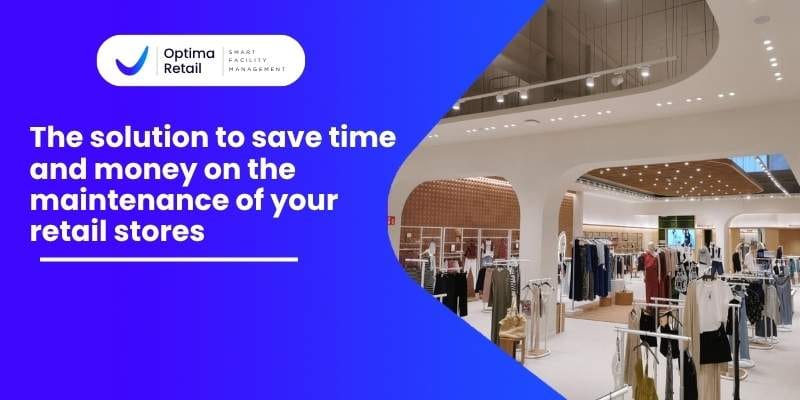
In a market competitive, a management efficient of stores, shops and retail is essential to maximise sales and deliver an excellent experience to customer.
To achieve this, it requires strategies well defined that involve fromthe administration of the inventory tothe management of the inventory. inventory to the management of personnel and the use of advanced technologies.
Optima Retail, specialists in comprehensive retail maintenance services, guides you through the most important aspects so that you can optimise every aspect of your business.
What does retail and shop management involve?

store management and retail management encompasses all processes involved in the day-to-day operation of a shop or network of shops, both physical and online. It includes everything from inventory organisation and space layout to staff training and customer service. The main objective is to ensure that all these elements work harmoniously together to deliver a smooth and satisfying shopping experience.
Keys to a management success in retailing
Managing a a shop in a way effectively involves monitoring many aspects at the time. Aquí te presentamos los pilares fundamentales que debes considerar:
Real-time inventory management
One of the most critical areas in shop management is inventory management. Without proper control, you can face problems such as overstock or shortage of products, both of which are detrimental to sales.
Tips key to efficient management of inventory:
- Automation: Use tools that update the inventory in real time.
- Analysis predictive: Rely on data historical and trends to predict demand.
- Audits regular: Performs reviews periodically of theinventory to avoid errors.
Phrase outstanding: “A precise control oftheinventory not only reduces costs, but that improves the satisfaction of customer to guaranteethe availability of products. “
Optimisation of shop space
The design and the layout of space within of. your shop have an impact directon sales. It is crucial that the design of your shop facilitates the navigation and promotesthe purchases impulsive.
Tips for optimising the space.
- Place key products in view: The most most sold or promoted must be in the areas of highest traffic.
- Zones of impulse near from the box: Place products small and from buy quick near from the boxes registers.
- Shelving and signage clear: Make sure of that the products are well: organised organised: that the products are. organised and labelled to facilitate the experience of purchasing.
Training of personnel
The sales team is one of the most influential factors in the customer’s perception of your brand. The continuous training of your staff is essential to provide exceptional service.
How to train your team effectively:
- Training in product: employees must knowto fund the productsin order to respond to queries from them customers.
- Habilidades de servicio al cliente: La cortesía, la paciencia y la proactividad son fundamentales en cualquier punto de venta.
- Motivation and incentives: Implement programmes of incentives to reward good performance and encourage a attitude positive.
Strategies of marketing at the point of sale.
The marketing in the store also plays an important role in attracting and converting customers. Take advantage of techniques such as visual merchandising, promotions and the events in store to boost sales.
Técnicas de marketing en retail:
- Offers limited: promotions for time limited create a sense of urgency and encourage impulsive purchasing.
- Visual merchandising: Highlighting key products using lights and decorations that call attention.
- Events in store: Organise events or demonstrations to attract more customers and promote products specific.
The role of technology in management retailing
La adopción de tecnología avanzada ha revolucionado la manera en que las tiendas y comercios gestionan sus operaciones diarias. Desde los sistemas de punto de venta (POS) hasta el análisis de datos de clientes, la tecnología permite mejorar la eficiencia operativa y proporcionar una mejor experiencia al cliente.
Systems of Point of Sale (POS)
The systems POS modern allow manage not only sales, but also the inventory and the relations with the customers, everything from one same platform. The benefits include:
- Updating in real time of theinventory.
- Reports of sales detailed.
- Integration with platforms ofmarketing to personalise promotions.
Analysis of data and CRM.
The data is the newest resource most valuablefor businesses retail. A through the collection and analysis of data, you can get insights about the behaviour of them. customers and adjust your strategies in function of it.
Advantages of analysis of data.
- Prediction of trends: Forecast the demand of products based on analysis of sales previous.
- Segmentation of customers: Groups them customers by habits of purchase and personalise offerings according their preferences.
- Optimisation of campaigns: Adjust your promotions and strategies ofmarketing in function of them data obtained.
Omnichannel retailing
omnicanality is a strategy imperative for modern retailers. Ensure of that the experience of customer is uniform and fluid between the channels physical and online, improves the loyalty of customer and maximisesthe opportunities of sale.
How to implement the omnicanality in your shop.
- Integrate channels online and offline: Allow them customers to buyon online and pick upat store (BOPIS).
- Inventory synchronised: Offer a unified view inventoryin all the points of sale.
- Comunicación unificada: Utiliza herramientas de CRM para gestionar las interacciones con los clientes a través de todos los canales.
Challenges and solutions in the management of shops.
Despite the availability of advanced technology and proven strategies, there are inherent challenges in retail management. A below, some of the problems most common and how to address them.
Adapting to changing customer expectations
Hoy en día, los clientes esperan más que nunca: experiencias de compra personalizadas, rapidez en el servicio y disponibilidad inmediata de productos. Para adaptarse a estas demandas, es crucial adoptar un enfoque focused on the customer.y optimizar cada aspecto de la experiencia de compra.
Management of them costs operational.
The high costs operational can be a burden on the businesses. To mitigate them, it is important to implement technologies of automation and improve the efficiency in the daily operations.
Are you ready to take the management of your store to thenext level? Contact us at Optima Retail for a budget tailored to the needs of your business. Don’t miss the opportunity of optimise every aspect of your business!


